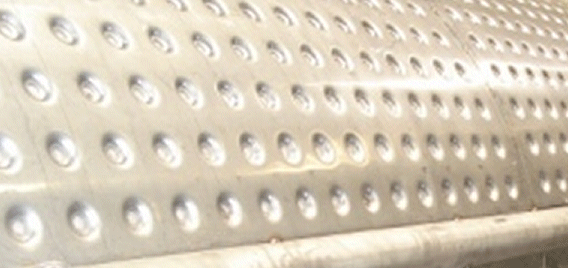Chemical and Process Engineering Resources

The design of dimple jackets permits construction from light gauge metals without sacrificing the strength required to withstand the specified pressure. This results in considerable cost saving as compared to convention jackets. Design calculation begin with an assumed flow velocity between 2 and 5 ft/s. As a rule of thumb the jacket pressure will be governing when internal pressure of vessel is less than 1.67 times the jacket pressure.
The design of dimple jackets is governed by the National Board of Boiler and Pressure Vessel Inspectors and can be stamped in accordance with ASME Unfired Pressure Vessel Code. Dimple jackets are limited to a pressure of 300 psi by Section VIII, Div.I of the ASME Code. The design temperature is limited to 700 °F. At high temperatures, it is mandatory that jacket be fabricated from a metal having same thermal coefficient of expansion as that used in inner vessel.
 |  | |
| Figure 8: Vessel with Dimple Jacket Installed | Figure 9: Dimple Jacket Details |
Heat Transfer Coefficients: Dimple Jackets
| hj Do/k= j (NRe) (NPr)0.33 (For 1000 < NRe < 50,000) | Eq. (10) |
| Where: j = 0.0845 (w/x)0.368 (Amin/Amax)-0.383 NRe-0.305 w = center-to-center distance between dimples |
All other variables are as previously defined. Garvin (CEP Magazine, April 2001) reports an average error of 9.8% with manufacturers data for the above correlation and a maximum error of 30% over 116 data points. This results in average deviations in the heat transfer coefficient of 15-20% most of which was at velocities below 2 ft/s. Good agreement with manufacturers data was found between 3 and 6 ft/s. A recommended excess area of 15% should be used in this velocity range.
The correlation above is for integrally welded jackets (ie. jackets welded directly to the vessel). If a dimple jacket is clamped onto an existing vessel and adhered with heat transfer mastic, the overall heat transfer coefficient of the system will be very low. Mastic is used to try to minimize air pocket resistances between the vessel wall and the jacket. Historically, this arrangement results in poor heat transfer. A recommended overall heat transfer coefficient of 10-15 Btu/h ft2 °F should be used for such systems regardless of the utility used.
Pressure Drop: Dimple Jackets
The pressure loss in a dimple jacket can be estimated from the following for water or water-like fluids:
Pressure Loss in Jacket = (Total Lenght of Flow, ft) x ((0.40 x Velocity, ft/s) - 0.35)
Pressure Loss Across Entire Jacket (including inlets and outlets) = Pressure Loss in Jacket + (0.10)(Pressure Loss in Jacket)
The above estimates should be used for velocities ranging from 1.5 to 6 ft/s.
This method is based on a graph found on page 217 of the Encyclopedia of Pharmaceutical Technology by James Swarbrick.
For detailed design, it is advisable to rely on manufacturer's data for pressure drop calculations.

 FB
FB

2 Comments
Very useful guidance for designing Jacketed vessel. Thank you for your sharing.
thank you, but i have an situation here i already fabricated double jacket tank half pipe but i need another type of jacket to prevent marks of welding on the inner tank walls. kindly see below picture
http://postimg.org/image/4xhiuehkn/
http://postimg.org/image/ctl1tbqt3/
http://postimg.org/image/5cgfruqnr/
cloud you please advise